Why Farmers Deserve Price Security
- 11 Jan 2025
Introduction:
The future of Indian agriculture is at a crossroads. With the shrinking of the agricultural workforce and the diversion of fertile farmlands for urbanization, ensuring the sustainability of farming is a strategic imperative. Among the various support mechanisms for farmers, the Minimum Support Price (MSP) remains a central point of debate. Should there be a legal guarantee for MSP? This question has gained prominence, especially with the rising challenges in agriculture, from unpredictable climate patterns to volatile market prices.
The Decline of Agriculture and Its Impact
India’s agricultural sector faces a dual crisis: loss of both land and human resources. Prime agricultural lands across river basins, such as the Ganga-Yamuna Doab or the Krishna-Godavari delta, are being repurposed for real estate, infrastructure, and industrial projects. Additionally, the number of "serious farmers" – those deriving at least half of their income from agriculture – is dwindling. The number of operational holdings may be 146.5 million, but only a small fraction of these farmers remains committed to agriculture.
This decline threatens the future of India’s food security, as the country will need to feed a population of 1.7 billion by the 2060s. To sustain farming and ensure long-term food security, we must secure farmers' livelihoods. Price security, particularly through MSP, plays a crucial role in this context.
The Role of MSP in Securing Farmers
MSP is the government-mandated price at which it guarantees the purchase of crops if market prices fall below a certain threshold. It provides a safety net for farmers against price volatility. The process of fixing MSP involves recommendations by the Commission for Agricultural Costs and Prices (CACP), which takes into account factors such as the cost of production and market trends. Once approved by the Cabinet Committee on Economic Affairs (CCEA), MSP is set for various crops, including rice, wheat, and sugarcane.
For farmers to stay in business, there must be a balance between production costs and returns. Farming is a risky business – yield losses can occur due to weather anomalies, pest attacks, or other natural factors. However, price risks can be mitigated with a guaranteed MSP. This would encourage farmers to invest in their land and adopt modern farming technologies, which would boost productivity and reduce costs.
Arguments for and Against Legal MSP Guarantee
Supporters of a legal MSP guarantee argue that it would provide financial security to farmers, protecting them from unpredictable market conditions. It would also promote crop diversification, encourage farmers to shift from water-intensive crops to those less dependent on irrigation, and inject resources into rural economies, thus addressing distress in rural areas.
However, critics highlight several challenges with a legal guarantee for MSP. The most significant concern is the fiscal burden it would impose on the government, potentially reaching Rs. 5 trillion. Furthermore, such a system could distort market dynamics, discouraging private traders and leading to a situation where the government becomes the primary buyer of agricultural produce. This could be economically unsustainable, especially for crops with low yields. Additionally, legal MSP guarantees could violate World Trade Organization (WTO) subsidy principles, adversely impacting India’s agricultural exports.
The Way Forward: A Balanced Approach
Given the challenges associated with a legal MSP guarantee, alternative measures should be explored. Price Deficiency Payment (PDP) schemes, such as those implemented in Madhya Pradesh and Haryana, could be expanded at the national level. These schemes compensate farmers for the difference between market prices and MSP, ensuring price security without the fiscal burden of procurement.
Additionally, the government can focus on improving agricultural infrastructure, such as cold storage facilities, to help farmers better access markets and increase price realization. Supporting Farmer Producer Organizations (FPOs) could also help farmers by enhancing collective bargaining power and ensuring better prices for their produce. Moreover, gradual expansion of MSP coverage to include a wider range of crops would encourage diversification, reducing the dominance of rice and wheat.
Government Extends Special Subsidy on DAP
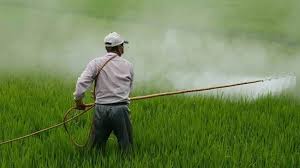
- 03 Jan 2025
In News:
The Indian government has decided to extend the special subsidy on Di-Ammonium Phosphate (DAP) fertilizer for another year, a decision aimed at stabilizing farmgate prices and addressing the challenges posed by the depreciation of the Indian rupee.
Key Government Decision
- Extension of Subsidy: The Centre has extended the Rs 3,500 per tonne special subsidy on DAP from January 1, 2025 to December 31, 2025.
- Objective: This extension aims to contain farmgate price surges of DAP, India’s second most-consumed fertilizer, which is being impacted by the fall in the rupee's value against the US dollar.
Fertilizer Price Dynamics and Impact
- MRP Caps on Fertilizers: Despite the decontrol of non-urea fertilizers, the government has frozen the maximum retail price (MRP) for these products.
- Current MRPs:
- DAP: Rs 1,350 per 50-kg bag
- Complex fertilizers: Rs 1,300 to Rs 1,600 per 50-kg bag depending on composition.
- Current MRPs:
- Subsidy on DAP: The subsidy includes Rs 21,911 per tonne on DAP, plus the Rs 3,500 one-time special package.
- Impact of Currency Depreciation:
- The rupee's depreciation has made imported fertilizers significantly more expensive.
- The landed price of DAP has increased from Rs 52,960 per tonne to Rs 54,160 due to the rupee falling from Rs 83.8 to Rs 85.7 against the dollar.
- Including additional costs (customs, port handling, insurance, etc.), the total cost of imported DAP is now Rs 65,000 per tonne, making imports unviable without further subsidy or MRP adjustments.
- The rupee's depreciation has made imported fertilizers significantly more expensive.
Industry Concerns and Viability Issues
- Import Viability:
- Fertilizer companies face significant cost pressures due to rising import prices and the current MRP caps.
- Without an increase in government subsidies or approval to revise MRPs upwards, imports will be unviable.
- Even with the extended subsidy, companies estimate a Rs 1,500 per tonne shortfall due to currency depreciation.
- Stock Levels and Supply Challenges:
- Current stock levels for DAP (9.2 lakh tonnes) and complex fertilizers (23.7 lakh tonnes) are below last year's levels.
- With inadequate imports, there are concerns about fertilizer supply for the upcoming kharif season (June-July 2025).
Government’s Strategy and Fiscal Implications
- Compensation for Imports:
- In September 2024, the government approved compensation for DAP imports above a benchmark price of $559.71 per tonne, based on an exchange rate of Rs 83.23 to the dollar.
- With the rupee falling below Rs 85.7, these previous compensation calculations have become outdated.
- Fiscal Impact:
- The extended subsidy will cost the government an additional Rs 6,475 crore. Despite this, political implications of raising the MRP are minimal, as only non-major agricultural states are facing elections in 2025.
Future Outlook and Priorities
- Immediate Priority: The government’s primary concern is securing adequate fertilizer stocks for the kharif season, focusing on ensuring sufficient imports of both finished fertilizers and raw materials.
- Balancing Factors: The government will need to navigate the complex balance of maintaining fertilizer affordability for farmers, ensuring the viability of fertilizer companies, and managing fiscal constraints.
As the subsidy extension is implemented, all eyes will be on the government's ability to ensure a stable supply of fertilizers while safeguarding both farmer interests and economic sustainability in the face of an increasingly challenging exchange rate environment.
Sustainable Groundwater Management in India’s Agriculture

- 30 Dec 2024
Introduction: Groundwater Crisis and Agriculture
- India's Agricultural Dependence on Groundwater: India is a leading producer of water-intensive crops like rice, wheat, and pulses. The country’s agricultural sector heavily depends on groundwater for irrigation, especially for paddy cultivation.
- Over-exploitation of Groundwater: Groundwater extraction for irrigation is increasingly unsustainable, threatening agricultural sustainability in the long term.
Rising Groundwater Usage and Its Implications
- Population Growth and Groundwater Use: Between 2016 and 2024, global population grew from 7.56 billion to 8.2 billion, and India’s population rose from 1.29 billion to 1.45 billion. Concurrently, groundwater used for irrigation increased from 38% in 2016-17 to 52% in 2023-24, exacerbating the water crisis.
- Over-extraction in Major Paddy-Producing States: States like Rajasthan, Punjab, and Haryana have witnessed severe over-exploitation of groundwater for irrigation.
- Rajasthan: Highest groundwater salinisation (22%) despite receiving the highest average rainfall (608 mm) among these states.
- Punjab and Haryana: Lesser groundwater salinity due to canal irrigation and micro-irrigation systems.
Impact of Excessive Fertilizer Use on Groundwater Quality
- Soil Salinity and Groundwater Contamination: Excessive use of fertilizers, particularly for paddy cultivation, increases soil salinity and contributes to groundwater contamination.
- Toxic Chemicals in Groundwater: Nitrate contamination, caused by nitrogen-based fertilizers, and uranium contamination due to phosphate fertilizers are key concerns in states like Maharashtra, Telangana, Andhra Pradesh, and Tamil Nadu.
- Health Risks: Contaminated groundwater poses health risks such as thyroid disorders, cancer, and dental fluorosis, along with reduced agricultural productivity.
Projected Impact on Future Groundwater Availability
- Unsustainable Groundwater Levels: The Central Groundwater Board (CGWB) reports that if current practices continue, over half of the districts in Punjab could face groundwater depletion. Similarly, 21-23% of districts in Haryana and Rajasthan may experience a similar crisis.
- Population Growth and Water Scarcity: With India’s population expected to reach 1.52 billion by 2036, the need for sustainable groundwater management becomes even more critical.
Government Initiatives for Groundwater Management
- National Mission for Sustainable Agriculture (2014): Promotes sustainable practices like zero tillage, cover cropping, and micro-irrigation for efficient water and chemical use.
- Pradhan Mantri Krishi Sinchai Yojana (2015): Aims to boost irrigation efficiency through drip and sprinkler irrigation methods.
- Atal Bhujal Yojana (2019): Targets efficient groundwater management in water-stressed states like Gujarat, Haryana, Rajasthan, Maharashtra, and Uttar Pradesh.
- Success of Government Initiatives: CGWB data shows that the percentage of districts with unsustainable groundwater levels dropped from 23% in 2016-17 to 19% in 2023-24.
Role of State Governments in Groundwater Management
- State-Level Initiatives: States with unsustainable groundwater levels must take proactive measures to manage water resources efficiently.
- Example - Odisha: Odisha's Integrated Irrigation Project for Climate Resilient Agriculture emphasizes irrigation efficiency and climate-smart practices, supported by World Bank funding.
- Encouraging Resource-Efficient Agriculture: States with safe groundwater levels, like Chhattisgarh, Bihar, Jharkhand, Telangana, and Odisha, should adopt water-efficient practices to protect groundwater resources.
Conclusion: Ensuring Agricultural Sustainability and Water Security
- Need for Urgent Action: Scaling up efforts to improve irrigation practices and groundwater management is crucial to securing India’s agricultural future.
- Global Food Security: Protecting groundwater resources will not only ensure water security within India but also contribute to global food security amid climate challenges.
- Blueprint for Sustainable Agriculture: States like Odisha are providing a model for sustainable water management, which can be replicated across water-stressed regions in India.
Agrarian Crisis in India
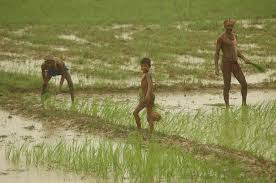
- 15 Dec 2024
Introduction
- Supreme Court Committee Report: A high-level committee, appointed by the Supreme Court in September 2024, submitted its interim report on November 21, 2024, highlighting the severe distress in India's agricultural sector.
- Key Focus Areas:
- Income crisis faced by farmers
- Rising debt burden
- Farmer suicides
- Stagnation in agricultural growth
- Impact of climate change
Key Findings of the Supreme Court Committee Report
Income Crisis in Indian Agriculture
- Daily Earnings: Farmers earn an average of just Rs 27 per day from agricultural activities, a meager income that makes it impossible to sustain a decent standard of living.
- Average Household Income: Agricultural households have an average monthly income of Rs 10,218, far below the basic threshold for a decent life.
Escalating Debt Burden
- Institutional Debt: In 2022-23, Punjab's institutional debt was Rs 73,673 crore, and Haryana's was Rs 76,630 crore.
- Non-Institutional Debt: This burden is further exacerbated by non-institutional debt, contributing 21.3% of total debt in Punjab and 32% in Haryana.
Farmer Suicides
- High Suicide Rates: Over 400,000 farmers and agricultural workers have committed suicide since 1995, primarily due to escalating debt and financial despair.
- Survey Findings: In Punjab, a survey found 16,606 suicides among farmers and farm workers between 2000 and 2015.
Stagnation in Agricultural Growth
- Growth Rates: Between 2014-15 to 2022-23, Punjab's agricultural growth was a mere 2% per year, and Haryana’s was 3.38%, far below the national average.
Disproportionate Employment
- Workforce Participation: 46% of India’s workforce is employed in agriculture, but it contributes only 15% to national income. Many farmers face disguised unemployment and underemployment.
Impact of Climate Change
- Environmental Degradation: Climate change, water depletion, erratic rainfall, and soil degradation are further destabilizing the agricultural sector and threatening food security.
Challenges Faced by the Agricultural Sector
1. Limited Access to Credit and Finance
- Small Farmers: 86% of Indian farmers are small and marginal, struggling to access institutional credit, which limits their ability to invest in modern agricultural inputs.
2. Fragmented Landholdings
- Small Landholdings: The average landholding is 1.08 hectares, insufficient for large-scale, efficient farming, limiting the adoption of modern agricultural techniques.
3. Outdated Farming Practices
- Traditional Methods: Many farmers continue using traditional, inefficient farming practices due to limited access to modern technology.
4. Water Scarcity and Irrigation Issues
- Dependence on Monsoons: 60% of cropped area is rainfed, and only 52% of gross sown area is irrigated, exacerbating vulnerability to droughts and erratic rainfall.
5. Soil Degradation and Erosion
- Degraded Land: 30% of India's agricultural land is affected by soil degradation, leading to lower productivity and reduced resilience to pests.
6. Inadequate Agricultural Infrastructure
- Post-Harvest Losses: Insufficient storage, cold chain, and rural infrastructure result in 15-20% post-harvest losses, further reducing farmers' income.
Government Schemes for Farmers' Welfare
- PM Kisan Samman Nidhi Yojana: Direct income support for farmers.
- PM Fasal Bima Yojana (PMFBY): Crop insurance scheme.
- PM Krishi Sinchai Yojana (PMKSY): Irrigation schemes to enhance water availability.
- e-NAM: National electronic market for better price realization.
- Agriculture Infrastructure Fund: Financial support for infrastructure development.
- Promotion of Farmer Producer Organizations (FPOs): Empowering farmers through collective marketing and production.
Recommendations for Addressing the Crisis
1. Loan Waivers and Debt Relief
- Debt Alleviation: Immediate measures to reduce the crushing debt burden through loan waivers, a key factor behind farmer suicides.
2. Legal Recognition of Minimum Support Price (MSP)
- MSP Protection: Granting legal backing to MSP to ensure farmers receive a fair price for their produce, reducing price volatility and income insecurity.
3. Promotion of Sustainable Farming
- Organic Farming: Encouraging organic farming and crop diversification to improve soil health and reduce dependency on a few staple crops.
- Climate-Resilient Agriculture: Adopting water-efficient practices, drought-resistant crops, and sustainable farming techniques.
4. Agricultural Marketing Reforms
- Market Efficiency: Improving the agricultural marketing system by establishing farmer-friendly markets and reducing intermediaries to ensure better price realization.
5. Rural Employment Generation
- Diversification: Creating non-agricultural employment opportunities in rural areas through skill development and promoting agro-based industries.
6. Climate Adaptation Measures
- Water Management: Enhancing water management systems and promoting rainwater harvesting.
- Resilience to Climate Change: Investing in climate-resilient infrastructure and farming technologies.
Implications of the Findings
Economic Impact
- Agricultural Decline: Continued neglect of the agricultural sector poses a risk to India's economy, potentially leading to long-term economic instability and increased rural-urban migration.
Food Security
- Threat to National Food Security: Declining agricultural productivity, exacerbated by climate change and inadequate reforms, threatens the country’s ability to meet food demands.
Social Stability
- Farmer Suicides and Unrest: The ongoing crisis, marked by widespread suicides and growing despair, risks social instability and unrest, particularly in rural regions.
Conclusion: Urgent Need for Reform
The committee’s report underscores the critical need for comprehensive reforms in India’s agricultural sector to alleviate the crisis. Immediate action is required to address the debt burden, improve incomes, and ensure sustainable agricultural practices. Legal reforms like MSP recognition and debt relief, along with investments in infrastructure and climate resilience, are key to securing a stable future for Indian agriculture.
National Mission on Natural Farming (NMNF)
- 29 Nov 2024
In News:
The Union Cabinet recently approved the launch of the National Mission on Natural Farming (NMNF), marking a significant shift in the government's approach to agriculture. This initiative, a standalone Centrally Sponsored Scheme under the Ministry of Agriculture & Farmers' Welfare, aims to promote natural farming across India, focusing on reducing dependence on chemical fertilizers and promoting environmentally sustainable practices.
What is Natural Farming?
Natural farming, as defined by the Ministry of Agriculture, is a chemical-free agricultural method that relies on inputs derived from livestock and plant resources. The goal is to encourage farmers to adopt practices that rejuvenate soil health, improve water use efficiency, and enhance biodiversity, while reducing the harmful effects of fertilizers and pesticides on human health and the environment. The NMNF will initially target regions with high fertilizer consumption, focusing on areas where the need for sustainable farming practices is most urgent.
Evolution of Natural Farming Initiatives
The NMNF is not an entirely new concept but a scaled-up version of the Bhartiya Prakritik Krishi Paddhti (BPKP) introduced during the NDA government's second term (2019-24). The BPKP was part of the larger Paramparagat Krishi Vikas Yojna (PKVY) umbrella scheme, and natural farming was also promoted along the Ganga River under the NamamiGange initiative in 2022-23. With the renewed focus on natural farming following the 2024 elections, the government aims to extend the lessons learned from BPKP into a comprehensive mission mode, setting a clear direction for sustainable agriculture.
In Budget speech for 2024-25, it was announced a plan to initiate one crore farmers into natural farming over the next two years. The mission will be implemented through scientific institutions and willing gram panchayats, with the establishment of 10,000 bio-input resource centers (BRCs) to ensure easy access to the necessary inputs for natural farming.
Key Objectives
The NMNF aims to bring about a paradigm shift in agricultural practices by:
- Expanding Coverage: The mission plans to bring an additional 7.5 lakh hectares of land under natural farming within the next two years. This will be achieved through the establishment of 15,000 clusters in gram panchayats, benefiting 1 crore farmers.
- Training and Awareness: The mission will establish around 2,000 model demonstration farms at Krishi Vigyan Kendras (KVKs), Agricultural Universities (AUs), and farmers' fields. These farms will serve as hubs for training farmers in natural farming techniques and input preparation, such as Jeevamrit and Beejamrit, using locally available resources.
- Incentivizing Local Inputs: The creation of 10,000 bio-input resource centers will provide farmers with easy access to bio-fertilizers and other natural farming inputs. The mission emphasizes the use of locally sourced inputs to reduce costs and improve the sustainability of farming practices.
- Farmer Empowerment: 30,000 Krishi Sakhis (community resource persons) will be deployed to assist in mobilizing and guiding farmers. These trained individuals will play a key role in generating awareness and providing on-ground support to the farmers practicing natural farming.
- Certifications and Branding: A major aspect of the mission is to establish scientific standards for natural farming produce, along with a national certification system. This will help in creating a market for organically grown produce and encourage more farmers to adopt sustainable practices.
Targeting High Fertilizer Consumption Areas
The Ministry of Agriculture has identified 228 districts in 16 states, including Uttar Pradesh, Punjab, Maharashtra, and West Bengal, where fertilizer consumption is above the national average. These districts will be prioritized for the NMNF rollout, as they have high fertilizer usage but low adoption of natural farming practices. By focusing on these areas, the mission seeks to reduce the over-dependence on chemical fertilizers and foster a transition to more sustainable farming practices.
Benefits of Natural Farming
The NMNF aims to deliver multiple benefits to farmers and the environment:
- Cost Reduction: Natural farming practices can significantly reduce input costs by decreasing the need for costly chemical fertilizers and pesticides.
- Soil Health and Fertility: By rejuvenating the soil through organic inputs, natural farming improves soil structure, fertility, and microbial activity, leading to long-term agricultural sustainability.
- Climate Resilience: Natural farming enhances resilience to climate-induced challenges such as drought, floods, and waterlogging.
- Healthier Produce: Reduced use of chemicals results in safer, healthier food, benefitting both farmers and consumers.
- Environmental Conservation: The promotion of biodiversity, water conservation, and carbon sequestration in soil leads to a healthier environment for future generations.
Conclusion
The launch of the National Mission on Natural Farming represents a critical step toward transforming India's agricultural practices into a more sustainable and environmentally friendly model. By targeting regions with high fertilizer usage, providing farmers with the tools and knowledge for natural farming, and creating a system for certification and branding, the government hopes to make natural farming a mainstream practice. As India continues to grapple with the challenges of climate change, soil degradation, and health risks from chemical inputs, the NMNF provides a promising framework for sustainable agriculture that benefits farmers, consumers, and the environment alike.
India’s Agricultural Sector
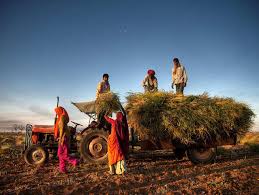
- 23 Nov 2024
In News:
India’s agricultural sector, which employs 42.3% of the population, is crucial to the nation’s economy. However, it faces a range of challenges that need to be addressed to ensure long-term stability, food security, and sustainable growth.
Current Performance of India’s Agricultural Sector
- Key Agricultural Metrics and Growth
- Foodgrain Production: India produced 330.5 million metric tonnes (MT) of foodgrains in 2022-23, maintaining its position as the world’s second-largest producer.
- Horticulture Production: A record high of 351.92 million tonnes in horticultural production was achieved, marking a 1.37% increase from the previous year.
- Market Outlook
- India’s agricultural market is projected to reach USD 24 billion by 2025.
- The food and grocery retail sector is ranked as the sixth-largest globally, with 70% of its sales generated from retail.
- Investment and Export Trends
- FDI in Agriculture: From April 2000 to March 2024, the agricultural services sector attracted USD 3.08 billion in foreign direct investment, while the food processing industry garnered USD 12.58 billion.
- Agricultural Exports: India’s agricultural and processed food exports reached USD 4.34 billion in 2024-25, including products like marine products, rice, and spices.
Key Challenges Confronting India’s Agriculture
- Climate Change and Environmental Impact:Extreme weather events, such as heatwaves and erratic rainfall, continue to impact agricultural productivity. In 2023, India experienced its second-warmest year on record, contributing to crop damage and rising food prices.
- Water Stress and Irrigation Inefficiency: Agriculture consumes the majority of India’s water resources, but irrigation efficiency is still low. The country relies heavily on flood irrigation, which leads to significant water wastage. Only 11% of agricultural land is under micro-irrigation, far below global standards.
- Land Fragmentation and Declining Farm Sizes: The average size of agricultural farms has decreased from 1.08 hectares in 2016-17 to 0.74 hectares in 2021-22, hindering the adoption of modern farming practices and mechanization.
- Market Access and Price Realization: Farmers continue to face challenges in accessing fair market prices due to the dominance of intermediaries and inadequate market infrastructure. Despite reforms like e-NAM, price gaps between farm-gate and retail prices persist, leaving farmers with a smaller share of the final price.
- Technology Adoption and Digital Divide: Although agritech is growing in India, only 30% of farmers use digital tools in agriculture, and rural digital literacy is just 25%, which limits the widespread adoption of modern farming solutions.
Addressing Structural Issues in Indian Agriculture
- Soil Health and Sustainability:The excessive use of chemical fertilizers and mono-cropping practices has led to soil degradation. Approximately 30% of agricultural land in India is experiencing degradation, impacting productivity and sustainability. Stubble burning further exacerbates this issue, worsening air quality and soil health.
- Crop Diversification Challenges:Many farmers are locked into the wheat-rice cycle due to Minimum Support Price (MSP) guarantees, limiting the cultivation of other crops like pulses and oilseeds. Although India is the largest producer of pulses, the domestic production is insufficient to meet the growing demand.
- Feminisation of Agriculture:Women make up 63% of agricultural workers but own only 11-13% of the operational land, limiting their access to resources and decision-making power. This gender disparity hampers their economic security and limits their participation in agricultural development.
Conclusion
India’s agricultural sector holds immense potential but is facing significant structural challenges that must be addressed to ensure its long-term growth and sustainability. Urgent reforms are needed to address issues like climate vulnerability, inefficient irrigation, land fragmentation, and limited market access. Additionally, fostering technology adoption, improving infrastructure, and addressing gender disparities will be crucial for improving the sector's performance and securing India’s food security needs.
National Agriculture Code (NAC)

- 07 Oct 2024
Introduction
The Bureau of Indian Standards (BIS) is in the process of developing the National Agriculture Code (NAC), which aims to establish standardized practices across the agricultural sector. This initiative mirrors existing frameworks such as the National Building Code and the National Electrical Code.
Purpose of the National Agriculture Code
The NAC seeks to standardize agricultural practices throughout the entire agricultural cycle, ensuring consistency and quality in farming operations. It will serve as a comprehensive guide for farmers, agricultural institutions, and policymakers.
Structure of the NAC
The NAC will be divided into two main parts:
- General Principles: Applicable to all crops, providing a foundational framework.
- Crop-Specific Standards: Tailored standards for key crops such as paddy, wheat, oilseeds, and pulses.
Coverage of the NAC
The code will encompass a wide range of agricultural processes, including:
- Agricultural Cycle: From crop selection to post-harvest operations.
- Post-Harvest Operations: Including standards for storage, processing, and traceability.
- Emerging Practices: Guidelines for natural and organic farming, as well as the integration of Internet-of-Things (IoT) technologies.
- Input Management: Recommendations for the use of fertilizers, pesticides, and weedicides.
Objectives of the National Agriculture Code
The BIS outlines several key objectives for the NAC:
- Standardization: Create a national code that reflects the diverse agro-climatic zones and socio-economic conditions across India.
- Quality Culture: Act as a reference for policymakers and regulators to enhance agricultural quality.
- Guidance for Farmers: Provide a practical guide to assist farmers in making informed decisions.
- Integration of Standards: Combine existing Indian standards with agricultural practices.
- Modernization: Emphasize aspects such as SMART farming, sustainability, and documentation.
- Capacity Building: Support training programs conducted by agricultural extension services.
Implementation Timeline
The BIS has established working panels comprising university professors and research organizations to draft the NAC, with a target completion date set for October 2025. Following this, training programs for farmers will be organized, facilitated by universities with financial assistance from the BIS.
Standardized Agriculture Demonstration Farms (SADF)
In conjunction with the NAC, the BIS is launching Standardized Agriculture Demonstration Farms (SADFs) at select agricultural institutions. These farms will serve as experimental sites to test and implement agricultural practices aligned with Indian standards. Partnerships with prominent agricultural institutes are being formalized through Memorandums of Understanding (MoUs), with two agreements already signed, including one with Govind Ballabh Pant University of Agriculture and Technology.
Significance of the NAC
- Uniform Standards: Promotes best practices in diverse agricultural environments.
- Stakeholder Guidance: Provides a structured framework for informed decision-making.
- Support for Modern Techniques: Encourages the adoption of innovative practices and technologies.
- Farmer Empowerment: Facilitates training and capacity building for enhanced productivity.
Challenges and Limitations
- Implementation Barriers: Standardizing practices across varied climates and soil conditions may prove challenging.
- Adoption Resistance: Smaller farmers might struggle with resource availability or awareness of new practices.
- Dynamic Agricultural Needs: The need for frequent updates to the NAC to keep pace with evolving agricultural trends.
- Infrastructure Constraints: Rural areas may lack the necessary infrastructure to effectively implement NAC guidelines.
Conclusion
The National Agriculture Code represents a pivotal move towards modernizing and standardizing agricultural practices in India. While it aims to enhance productivity and sustainability, its success hinges on effective implementation, farmer engagement, and ongoing updates to meet the changing landscape of agriculture.
Drone Technology in Agriculture
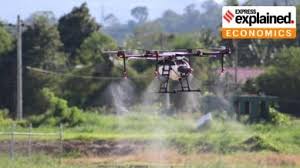
- 02 Sep 2024
In News:
Farmers in Bhagthala Khurd, Kapurthala, and Amritsar are increasingly using drones to apply pesticides to their maize and moong crops. Drones, also known as unmanned aerial vehicles (UAVs), are advanced flying machines that can be operated either autonomously or via remote control.
Drone Technology in Agriculture
While the use of drones in Indian agriculture is still emerging, it shows great potential. In Punjab, 93 out of the 100 drones provided to farmers by the Indian Farmers Fertiliser Cooperative (IFFCO) under the Centre’s ‘NAMO Drone Didi’ scheme are already in operation. Each drone, costing Rs 16 lakh, is equipped with a 12-litre water tank.
Benefits
- Health Protection: Drones minimize farmers' direct exposure to harmful pesticides, reducing the risk of health issues like cancer and kidney problems.
- Efficiency: Drones can spray an acre in just 5-7 minutes, significantly faster than the several hours required for manual application. They ensure a uniform application, which can enhance crop yields.
- Data Collection: Drone data helps pinpoint areas requiring attention, leading to better crop management and increased profits.
- Nano Fertilisers: Drones effectively handle nano fertilisers, ensuring even distribution of these small quantities that are difficult to spread manually.
- Pest Control: Drones enable timely application of pesticides during infestations of pests such as pink bollworms, locusts, and whiteflies.
- Environmental Benefits: Drones improve nutrient absorption from nano fertilisers by up to 90%, reducing runoff and pollution. Leaf-based application is also less polluting than soil-based methods.
- Water Conservation: Drones reduce water usage by up to 90% compared to traditional methods.
- Cost Reduction: They decrease the need for manual labor and reduce pesticide and chemical use, lowering overall costs.
- Additional Uses: Drones are also used to drop seed balls (a mix of soil and cow dung with seeds) for potential reforestation projects.
Challenges
- Job Loss: The use of drones may reduce demand for manual labor, affecting job opportunities for laborers.
- Knowledge and Training: Farmers may lack the necessary skills and training to operate drones effectively.
- Cost: The high cost of drones can be a significant barrier for many farmers.
- Regulatory Barriers: Regulatory challenges may complicate the adoption of drones in agriculture.
Initiatives
- Digital India Campaign: Aims to enhance digital infrastructure and provide training.
- Indian Council of Agricultural Research (ICAR): Promotes precision agriculture technologies, including drones.
- Production Linked Incentive (PLI) Scheme: Offers Rs. 120 crore (US$ 14.39 million) to incentivize domestic drone manufacturing and reduce import reliance.
- Sub-Mission on Agricultural Mechanization (SMAM): Provides financial aid to farmers purchasing drones, making technology more accessible.
- NAMO Drone Didi Scheme: Launched to empower women Self-Help Groups (SHGs) and provide access to modern agricultural technology.
- Support and Training: Efforts are underway to offer training and support to farmers to overcome adoption barriers.
Conclusion and Way Forward
Drone technology holds the promise of transforming agriculture by boosting efficiency, yields, and cost-effectiveness. In Punjab, where traditional manual methods have prevailed, drones offer a new approach to pesticide and fertiliser application. It is essential for farmers and policymakers to work together to address challenges and ensure that the benefits of drones are fully realized while mitigating any potential drawbacks.
The role of district agro-met offices in supporting farmers

- 10 Sep 2024
In News:
- Last week, PTI reported that the India Meteorological Department (IMD) is planning to revive District Agro-Meteorology Units (DAMUs) under the Gramin Krishi Mausam Sewa (GKMS) scheme.
Background:
- The IMD established 199 DAMUs in 2018 in collaboration with the Indian Council of Agricultural Research.
- The aim was to use weather data to prepare and disseminate sub-district level agricultural advisories. In March, DAMUs were shut down following an order issued by the IMD.
Why are agro-met units important?
- Around 80% of farmers in India are small and marginal. They largely practise rain-fed agriculture in the backdrop of a decades-long farm crisis that is now overlaid with climate change-related weather variability.
- The DAMUs were located within Krishi Vigyan Kendras (KVKs). Scientists and researchers trained in meteorology and agriculture were recruited as DAMU staff. They used weather data provided by the IMD like rainfall, temperature and wind speeds to prepare agricultural advisories related to sowing and harvesting, usage of fertilizers and pesticides, irrigation etc.
- These advisories were sent to millions of farmers across the country free-of-cost in local languages twice a week. They were shared via text messages, WhatsApp groups, newspapers and also through in-person communication from DAMU staff and KVK officers.
- Since these advisories provided weather information in advance, they helped farmers plan activities like irrigation. They also served as early warnings for extreme events like droughts and heavy rainfall. Many studies conducted over the years have stressed the benefits of agro-met advisories.
Why were DAMUs shut down?
- According to an Article-14 report, the NITI Aayog misrepresented the role of District Agricultural Management Units (DAMUs) and advocated for their privatization. The report claims that NITI Aayog inaccurately stated that agro-met data was automated, thereby diminishing the role of DAMU staff. In reality, DAMU staff were crucial in creating agricultural advisories based on IMD weather data, which were disseminated to farmers in local languages. NITI Aayog also proposed monetizing these services, contrasting with the current free provision of agro-met information to all farmers.
- A policy brief from the National Institute of Advanced Studies (NIAS), Bangalore, released in August, highlights that localized and accessible advisories from District Agricultural Management Units (DAMUs) have significantly improved farmers' responses to climatic variations in the Kalyana-Karnataka region. This has led to increased yields and incomes. The brief recommends reconsidering the decision to discontinue DAMUs and suggests exploring ways to enhance their effectiveness and presence.
What about private players?
Currently, a few private companies offer weather advisories, but their services are often too costly for small and marginal farmers. Dr. M. N. Thimmegowda, a professor at the University of Agricultural Sciences noted that annual subscriptions can cost ?10,000 per crop, leading to expenses of ?20,000-40,000 for vegetable and cereal growers, and up to ?60,000-80,000 for specialized advisories. Additionally, there is concern that these companies may provide biased recommendations for fertilizers and pesticides, favoring certain brands.
Need for a Farmer-Friendly Agri-Export Policy
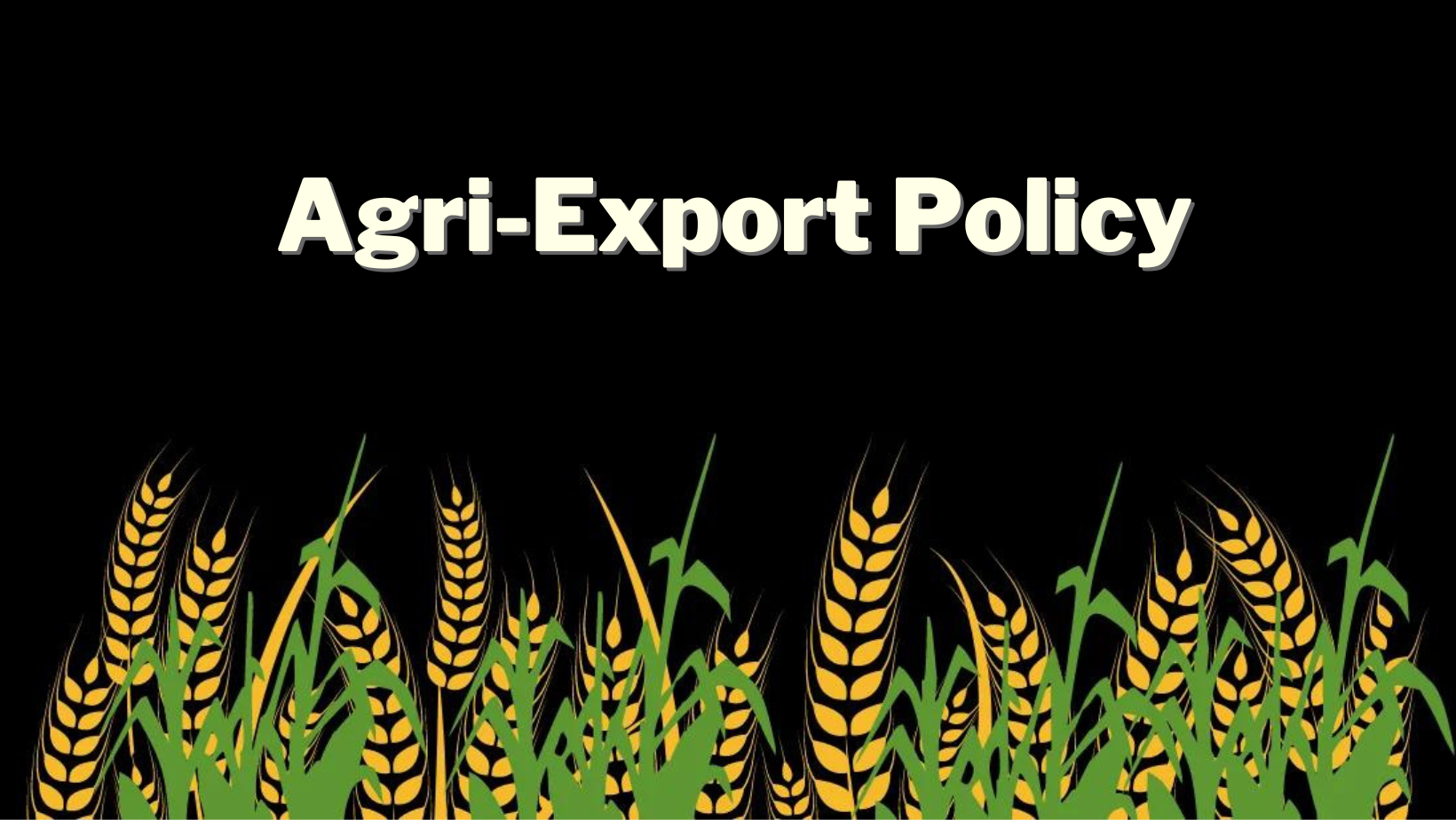
- 14 May 2024
Why is it in the News?
The current government policy, skewed towards consumers, unfavourably impacts farmers, necessitating a shift to enhance farmers' incomes.
Current State of India‘s Agricultural Exports:
- The current status of India's agri exports highlights a notable shortfall in achieving government targets.
- Despite aiming for $60 billion in 2022, actual exports in 2023-24 amounted to $48.9 billion, showing an 8% decrease from the previous year's $53.2 billion.
- Between 2004-05 and 2013-14, agricultural exports witnessed remarkable growth, expanding nearly fivefold from $8.7 billion to $43.3 billion.
- However, this growth trajectory slowed significantly in the period from 2014-15 to 2023-24, with an annual growth rate of merely 1.9%.
- Key exports include rice ($10.4 billion), marine products ($7.3 billion), spices ($4.25 billion), bovine meat ($3.7 billion), and sugar ($2.8 billion).
What is Agricultural Export Policy?
- The Agricultural Export Policy, commonly known as an agri-export policy, encompasses a range of governmental regulations, strategies, and incentives aimed at facilitating and encouraging the export of agricultural commodities from a specific nation.
- It encompasses diverse measures such as export subsidies, tariff adjustments, quality benchmarks, market access arrangements, financial support, and promotional efforts to assist agricultural producers and exporters in accessing global markets, enhancing their competitiveness, and broadening their export horizons.
- The Government of India introduced a comprehensive Agriculture Export Policy in December 2018, with the following objectives:
- To diversify our export basket, and destinations and boost high-value and value-added agricultural exports, including focus on perishables.
- To promote novel, indigenous, organic, ethnic, traditional and non-traditional Agri products exports.
- To provide an institutional mechanism for pursuing market access, tackling barriers and dealing with sanitary and phytosanitary issues.
- To strive to double India’s share in world agri exports by integrating with global value chains.
- Enable farmers to get the benefit of export opportunities in overseas markets.
What is the Need for an Agri-Export Policy?
- Economic Contribution: India's agricultural exports, totalling around USD 53 billion in the fiscal year 2022-2023, constitute a significant portion of overall exports, yet the country's global share in agricultural exports remains low at 2.2% as of 2016.
- Food Security Enhancement: Despite catering to a substantial portion of the world's population with limited resources, a well-designed export policy can generate additional revenue to invest in bolstering food security and augmenting farmers' incomes.
- Inflation Control: Agricultural exports have the potential to stabilize domestic prices, benefiting consumers and producers, particularly during periods of abundant harvests.
- Job Creation: With approximately 45% of the workforce engaged in agriculture, promoting agricultural exports can foster employment opportunities, particularly in rural areas where agriculture is predominant.
- Balance of Payments Support: Agricultural exports significantly contribute to India's foreign exchange reserves, helping to offset trade deficits and maintain currency stability.
- Crop Diversity Utilization: India's diverse agricultural production offers substantial export potential, which can be tapped into through a well-structured export policy.
- Trade Relations Strengthening: Agricultural exports are pivotal in fostering and reinforcing trade ties with countries like the United States, Saudi Arabia, and the United Arab Emirates.
- Addressing Structural Challenges: The policy framework can effectively tackle obstacles such as low farm productivity, inadequate infrastructure, global price fluctuations, and limited market access.
What are the Challenges in India's Agri-Export Policy?
Several challenges hamper the effectiveness of India's agricultural export policy, requiring strategic interventions to unleash the sector's full potential:
- Restrictive Export Policies: Favoring domestic consumers over farmers often impedes the achievement of export targets.
- Restrictions on commodities like Basmati rice, such as the Minimum Export Price (MEP) of USD 1,200, can limit export volumes.
- Subsidy-Centric Schemes: Increased subsidies during election periods, including food and fertilizer subsidies, strain fiscal discipline.
- Populist measures like loan waivers and free power for farmers impact the financial health of the agricultural sector.
- Insufficient R&D Investment: Low investment in agricultural R&D, approximately 0.5% of agricultural GDP, hinders growth prospects.
- Doubling or tripling R&D investments is essential for India to excel in agricultural production and exports.
- Quality and Standards: Maintaining consistent quality and meeting international standards is challenging.
- Variability in quality, compliance issues, and difficulties in meeting Sanitary and Phytosanitary (SPS) Measures due to pests and diseases impede exports.
- Infrastructure: Inadequate infrastructure for storage, transportation, and processing results in post-harvest losses, reducing export competitiveness.
- Environmental and Sustainability Concerns: Balancing the growth of agricultural exports with environmental sustainability is crucial.
- Over-exploitation of resources may have long-term consequences, necessitating careful resource management and sustainable practices.
Government Initiatives Promoting Agri-Export in India:
To unlock the full potential of India's agricultural exports, the government has launched several initiatives to enhance productivity, modernise infrastructure, and promote sustainable practices. Key schemes include:
- E-NAM (National Agriculture Market): A pan-India electronic trading portal, E-NAM enables farmers to sell directly to buyers, reducing intermediaries and ensuring fair prices.
- E-NAM has integrated 1,000 wholesale markets and 585 mandis across 18 states and 3 Union Territories.
- National Horticulture Mission (NHM): Promoting sustainable horticulture practices, including organic farming and precision farming, NHM supports the establishment of over 100 Farmer Producer Organizations (FPOs) for horticultural products.
- The mission also backs the production of high-value horticultural products for export.
- Market Access Initiative (MAI): Supporting export promotion activities, such as participation in trade fairs, capacity building, and market research, MAI has facilitated Indian exporters' participation in over 100 international trade fairs annually.
- Operation Greens: With an allocation of INR 500 crores in the Union Budget 2023-2024, Operation Greens stabilizes the supply and prices of essential agricultural commodities like fruits and vegetables.
- The scheme reduces price volatility, ensures fair prices for farmers, and fosters sustainable agri-exports.
- Scheme for Agro-Marine Processing and Development of Agro-Processing Clusters (SAMPADA): With a budgetary allocation of INR 6,000 crores for the period 2020-2021 to 2024-2025, SAMPADA modernizes infrastructure for agro-processing clusters.
- This reduces post-harvest losses and increases shelf life, improving the overall export potential.
- APEDA: Promoting the export of scheduled products, APEDA provides guidelines for sustainability and quality.
- APEDA facilitated exports of agricultural products worth USD 22.17 billion during the financial year 2022-2023.
- Agri Export Zones (AEZs): AEZs provide infrastructure development and technology adoption for sustainable agri-exports.
- Established for commodities like mangoes, grapes, and spices, AEZs have contributed to increased export volumes.
- Promotion of Organic Farming: Initiatives promoting organic farming for environmental sustainability and the export potential of organic products have resulted in increased organic farming area, reaching 3.90 million hectares in 2022-2023, with exports of organic products totalling USD 1.04 billion.
Way Forward for a Stable Agricultural Export Policy in India:
To establish a stable and prosperous agri-export policy in India, several strategic actions and considerations must be taken into account. These include:
- Prioritizing Farmer Welfare: Ensuring that farmers receive fair prices for their produce is crucial for the success of agricultural exports and the well-being of the farming community.
- Supporting Domestic Consumers: Implementing targeted income policies to support vulnerable populations and maintain food security for domestic consumers.
- Enhancing Productivity: Increasing agricultural productivity through investments in R&D, seeds, irrigation, fertilizers, and improved farming practices to bolster global competitiveness.
- Diversifying Export Basket: Expanding the range of agricultural exports, focusing on value-added products, and targeting a wide array of international markets to minimize reliance on a select few commodities.
- Quality Assurance: Implementing strict quality standards and certification mechanisms to ensure that exported agricultural products meet international norms.
- Establishing uniform quality and standardization protocols is vital, particularly for horticultural items.
- Infrastructure Development: Investing in modern infrastructure, such as cold storage, processing facilities, transportation, and logistics, to reduce post-harvest losses and enhance export competitiveness.
- Offering financial incentives, subsidies, and credit facilities can encourage investments in agriculture, infrastructure, and processing facilities.
- Technology Adoption: Promoting the use of advanced agricultural technologies, precision farming, and efficient irrigation techniques to boost productivity.
- Encouraging the growth of agri-startups and fostering innovative solutions can enhance agricultural production and export efficiency.
- Environmentally Sustainable Practices: Encouraging sustainable farming practices, including organic farming, to ensure environmental sustainability in agriculture.
- Learning from Global Best Practices: Gaining insights from successful agricultural export policies and best practices in other countries can inform India's approach.
- Strengthening diplomatic efforts to negotiate favourable trade agreements and reduce trade barriers will provide better access to international markets.
Conclusion
To ensure India's continued growth in global agricultural trade, a stable export policy is crucial, embodying dynamism, responsiveness, and adaptability. It must prioritize agricultural sustainability, environmental responsibility, and farmer welfare, securing India's position in international trade. Balancing economic growth with farmer well-being and environmental concerns is key to unleashing India's agricultural potential. Forward-looking policies and innovative solutions will strengthen the agri-export sector, fostering a prosperous and sustainable future for all.
